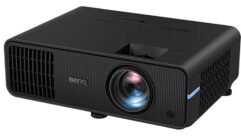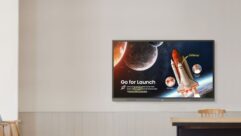A NEW PATH TO THE SCREEN
Apr 1, 2001 12:00 PM,
Peter H. Putman, CTS
There are several serious efforts to create alternative distribution networks for films that would operate outside of traditional Hollywood film distribution.
WHAT A DIFFERENCE A YEAR MAKES!
Twelve months ago, the cinema world was abuzz with talk of electronic cinema. Blue-ribbon panels discussed technical issues like content distribution and encryption. Side-by-side demos of film prints and digital transfers were screened at Sho-West 2000, provoking considerable debate about the merits of film vs. digital.
Texas Instruments signed up its “big three” DLP cinema partners: Barco, Digital Projection and Christie. Film festivals expanded their all-digital screenings, and two prominent directors, Bernard Rose and Mike Figgis, released all-digital feature films, shot in HD format. Fox, Cisco and Barco combined forces to stream a digital version of Titan A.E. via a secure network.
Today? It’s pretty quiet out there as far as e-cinema news goes. Advancements in electronic projection technology have been overshadowed by the financial woes of movie theater chains, who are forming their own “ticket lines” at bankruptcy courts. Carmike, United Artists and Loew’s have filed for Chapter 11 reorganization.
In addition, AMC has announced a plan to close down older cinemas and reduce its load of real-estate taxes and loan payments. All in all, it’s not the best business climate to try and sell high-brightness, high-resolution projectors — not to mention servers and other related equipment. Theater chains are more concerned with simply staying in the black and are cutting expenses wherever possible.
But opportunities may lie elsewhere. The increased number of digital film festival entries wouldn’t have been possible if e-cinema projectors didn’t exist. The fact that they do (and that they are much less mechanically complex than film projectors and preserve image quality after hundreds of screenings) has switched on lights over more than a few heads.
There are several serious efforts to create alternative distribution networks for films (the word “films” describes both filmed content transferred digitally and all-digital productions) that would operate outside the mainstream of traditional Hollywood film distribution. In some cases, these digital features, short subjects and documentaries would be available to both art cinemas and conventional multiplexes. In other cases, the distributor would develop and expand its own network of alternate cinema sites, using existing auditoriums, lecture halls and theaters on college campuses and in art centers.
Recently, I had an opportunity to learn more about two efforts to develop and nurture alternative cinema networks. One of these ventures — Emerging Cinemas, of New York City — plans to put digital projection systems in under-served markets where the demographics will support first-run art, foreign and non-mainstream digital releases.
The second venture — Madstone Films, also of New York City — is a bit more ambitious. Not only does its business plan include the development of digital distribution networks, but the company is providing direct financial and logistical support to up-and-coming directors. In effect, this creative talent is on the payroll for a 2-year period, eliminating many of the financial barriers to independent filmmakers.
EMERGING CINEMAS
The office of Emerging Cinemas is in lower Manhattan, and one of the founders will certainly be familiar to the production community. Barry Rebo is a pioneer in HDTV production. His partner, Giovanni Cozzi, is well-known as the former head of Vidikron USA, a manufacturer of high-end home theater systems.
“We believe there is a need to expand the distribution of films beyond the traditional Hollywood model,” said Rebo. “There are many under-served markets that have the right demographics to support art and alternative cinemas. The problem is that many of the potential customers in these markets live a long way from major metropolitan areas where art houses are usually located.”
The performance of existing art and showcase cinemas would seem to indicate a ripe market. “The last numbers I checked showed about 37,000 total screens in the United States, of which 2.5% would be considered specialty cinemas,” said Rebo. “The interesting thing is that this small group of theaters returned 5% of the total gross for all films released. The ticket buyers are there.”
Emerging Cinemas proposes to establish this network of electronic cinema venues in three ways. “First, we’re looking at existing performing arts centers,” said Cozzi. “Any college or university campus or community center would be a natural fit. These venues already attract the types of audiences who would support alternative cinemas, and the facilities are usually adequate for theatrical projection.”
Other possible venues would be science and technology centers. “These facilities already have theaters and auditoriums that can be retrofitted for electronic cinema,” he added. “Look at the newer museums that have been equipped with Imax theaters. Our plan is to add the capability of electronic projection as another option.”
Emerging Cinemas is also looking into rehabbing and updating existing multiplex cinemas. Currently, the staff is working with an older, smaller multiplex in Easton, Pennsylvania, to upgrade at least one of five theaters to a full e-cinema operation, supplementing the traditional 35mm film offerings. With Lafayette and Lehigh Universities nearby, and a growing number of New Jersey and New York commuters living there, the prospects look attractive.
“We also worked with the owners of a restored opera house in Claremont, New Hampshire,” said Cozzi. “This 750-seat facility was offering only 12 live stage shows a year. By adding in an electronic cinema system, the owners can now keep the facility open more days a week and expand their revenue stream.” Again, the potential audience draws from several nearby colleges and universities.
What about equipment? “We’ve tested both the SXGA Thunder DLP designs from Texas Instruments and JVC’s D-ILA platform,” Rebo replied. “We’ve conducted tests at the Walter Reade theater in mid-town Manhattan to see what the image quality would be under typical auditorium conditions. Tests were also run with DuArt Labs to determine the best way to transfer digital material and maintain the best image quality on either projector.”
Emerging Cinemas is having discussions with different venues as well as auditioning prospective films — some of which are high-definition versions of films already in traditional release. “The concept has met with an overly positive response,” said Cozzi. “We’re optimistic that we can re-invent art cinema and bring it to more people across the country in secondary markets.”
MADSTONE FILMS
“Let’s face it, a director’s ideas may be good, or they may be crap. But…if the director made a bad film, don’t blame it on the projection system or server technology. We’ll make sure those will be top-notch.”
— Jon Thompson, Madstone
Madstone Films is the brain-child of film industry veteran Tom Gruenberg and investment banker Chip Selig. It is described by its founders as “an incubator for new digital cinema content.” The concept is to put 15 novice filmmakers on the payroll for a 2-year period with annual salaries of $50,000 and a full benefits package. (How’s that for a radical departure from independent filmmaking?)
According to Gruenberg, Madstone will shoot and post all projects digitally, retrofit 50 movie theaters across the U.S. with digital cinema systems and show their product in those theaters. While budgets for these features could support 35mm production (typically $0.5 to $1.5 million each), the decision was to stay 100% digital and exploit this new form of cinema.
Madstone will provide a collaborative work environment for filmmakers at its Madison Avenue location, believing that the free exchange of ideas, opinions and suggestions can only result in a better product. The first three filmmakers to come on board are Joan Stein (student Academy Award winner for “One Day Crossing”), Aaron Woodley (director of short films “Bed and Breakfast” and “The Wager”), and Lisa Swie (director of “Happy Birthday and Other Catastrophes”).
Nathaniel Bonini, chief technical officer of Madstone, and Jon Thompson, vice-president of international markets, are responsible for implementing the projection end of the process. “We’re following the logical demographics that would maximize revenue streams and not necessarily going head-to-head with existing theater chains,” said Thompson. “Digital cinema makes sense because 35mm release print quality has gone up and down so much over the years.”
“The random quality is a real problem with 35mm prints. Even the best movie houses are not providing high-quality projection consistently,” he added. “Technicolor was far superior to Eastmancolor, but studios cut back to Eastmancolor to save money. Release prints today are very inconsistent in quality. Digital cinema could get us back to the days of Technicolor quality.”
“We’re looking at what TI has done with DLP Cinema, and want to take it to another level,” said Bonini. “We’re happy with the image quality, but feel we can improve on what they started with. If you look at the typical mall cinema image, there is already parity with e-cinema. As far as resolution is concerned, we consider contrast ratio and pixel depth to be a greater issue. Any system that does not reproduce what the film looks like is inadequate in our minds.”
How about production formats? “We won’t shoot in film at all. We’ll probably use the Panavision/Sony 1080p24 system,” said Bonini. “We’re also looking at other formats. After all, it’s up to the filmmakers to choose a digital format best suited to expressing their ideas. Madstone will enable directors to use any equipment they want to produce their projects as long as the format is digital.”
And how will theaters be equipped with electronic cinema projection systems? “Right now, Madstone is looking to acquire a theater chain,” Bonini pointed out. “The fact is, wherever there is a high-speed data link, we can send the films. The telecommunications infrastructure has become faster and cheaper.”
“There are many underserved markets that have the right demographics to support art and alternative cinemas.”
— Barry Rebo, Emerging Cinemas
“We can also work with competing exhibitors, provided they have e-cinema systems in place,” Thompson added. “The business arrangements (buy, lease, rent) will vary from theater chain to theater chain. Our responsibility is to develop the network and get the best looking images on screen. As for the cost of converting to e-cinema, the current buzz is that the studios may get stuck with the bill for upgrades. It’s a trade-off: Look at the savings in release print costs.”
Will electronic cinema really open up a new world of creativity? “One of the neat things about digital acquisition is the tools we’ve been seeing in music videos for years, with products like Discreet Logic’s offerings,” said Bonini. “This is something that someone will really have a field day with. After all, DJs can sample music and don’t need a whole band to record. With the same technology, you could create amazing and compelling digital films.
“Let’s face it, a director’s ideas may be good, or they may be crap,” said Thompson. “But e-cinema shows an idea can stand up on its own and is not limited by film production and projection methods. It comes down to this: If the director made a bad film, don’t blame it on the projection system or server technology. We’ll make sure those will be top-notch.”
GO WHERE THE MONEY IS
The manufacturers of high-brightness projection systems (also known as large-venue projectors) are looking long and hard at many markets for their products. The financial problems of establishment movie houses are largely self-inflicted wounds — too many new theaters packed into tight geographic areas.
As a result, the most promising markets for these projectors (and their accompanying server systems) may be theaters that don’t yet exist, or that will emerge from remodeling older multiplex houses. Emerging Cinemas and Madstone Films are probably the first wave of independent production and distribution companies who will try to expand and capitalize on art cinemas through digital cinema technology.
How do the major studios feel about it? While digital production and projection may be leveling the playing field, the perception at last November’s EnergyDigital screening of Bounce was that there’s still much to be said for the impressive marketing and advertising campaigns that come out of Hollywood.
“It takes a lot of advertising dollars to get people into theaters,” said Mark Gill, president of Miramax. “Will independent, boutique electronic cinema houses be able to put up that kind of money? Sustained advertising campaigns with TV, radio and newspaper exposure are effective, but they are expensive.”
Peter Putman owns PHP Communications, Doylestown, Pennsylvania. He is the author of The Toastmasters Guide to Audiovisual Presentations and reviews large-screen displays and computer/video interfaces.










